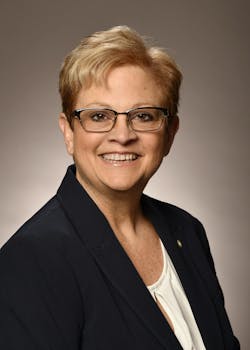Q&A: Denise Napier, President of Jefferson Health Plans
In December 2023, Philadelphia-based Jefferson Health and Allentown, Pa.-based Lehigh Valley Health Network (LVHN) announced plans to merge. Jefferson, which has grown through a series of mergers, will reach 30 hospitals and more than 700 sites of care, if the deal goes through. The enterprise has also wholly owned Jefferson Health Plans since 2021. Denise Napier, president of Jefferson Health Plans, recently spoke with Healthcare Innovation about the growth on the payer side.
HCI: We have reported on how Jefferson Health has been growing over the past few years on the provider side, including the recent announcement of a planned merger with Lehigh Valley Health Network. Could you talk about how the health plan arm been growing rapidly as well?
Napier: The health plan has been on a growth path for a few years. We went statewide with our Medicaid program in September of 2022. As we look at the health system going into other areas, such as Lehigh Valley, we're already there. Our Children's Health Insurance Program (CHIP) plan went live December 15, 2023, statewide. We grew from about 8,000 members just a couple of months ago to about 14,000 in CHIP now. We want to go as far statewide as we can with with Medicare Advantage, too. In Medicare Advantage, we have two populations that we serve. The 60 percent of our Medicare population are the dual-eligible. We started in Southeast Pennsylvania, and we're looking to expand that, and we just entered into the exchanges in Philadelphia, Bucks and Montgomery counties, and we are close to 10,000 lives in those. We also have a Medicare Advantage HMO in five counties of New Jersey.
HCI: Do you experience any efficiency gains as an integrated health system with the Jefferson provider organization in terms of care management or data flow?
Napier: As a health plan that has a comprehensive provider network, we follow the antitrust regulations. When we talk about data flowing, it's the Jefferson-attributed members that we can exchange data on. We are not on the same platform today, as many others are like Epic, but we can transfer data much more easily as an integrated delivery network, really focusing on gaps in care and focusing on all the Star measures. We also make sure that we have frequent communication with our provider offices. I do think that from an efficiency perspective, there's so much more to gain being an integrated delivery system because you have that common goal to make sure that you are servicing that member with SDOH, medical and behavioral health requirements. As we deal with other providers, we try to do the same thing. It all depends on whether or not you have the volume to gain their attention.
HCI: Can you give a few examples of how you work with providers?
Napier: We’ve got very strong relationships, especially in Southeastern Pennsylvania, where we've been for for 40 years, so we do many different things with providers. For instance, with Temple Health, we are working to make sure that people have a stable housing environment to receive care. If you're focused on North Philadelphia, which is one of the poorest cities in the country, those barriers to care are much more significant, so we try to build programs around that.
HCI: We’ve seen in other states that where they've received Medicaid waivers from CMS that allow Medicaid managed care companies to expand the type of services they offer. Is that happening in Pennsylvania?
Napier: Actually, we were the first plan to do food as medicine. We took it from our administrative fund, because at that time it was not reimbursable. But we said that we believe that long-term results are going to prove that nutrition is going to make somebody healthier, and in the long run, that's really where your savings comes from — trying to keep people healthy on the front end.
We started out in our Medicaid population centered around diabetes. And we’ve expanded into congestive heart failure and then we've also expanded it into our Medicare program. We've serviced about 2,200 members. We saw a 6.7 percent drop in hemoglobin A1c. We had inpatient visits decrease 38 percent and ER visits decrease 23 percent. When we were able to show the statistics to the state, they were very intrigued with the impact on our members. And now all the other managed care organizations are participating in that program.
One thing that the state is looking at and I know CMS is looking at it too is how do we incorporate housing now because you can't use Medicaid funds for housing, and that's why we're doing the grants for housing. So we're really hopeful that that'll be coming in the future.
We look at to improve the community because, especially in the government programs, it's really about trust and about community engagement. It's really grassroots, being a trusted partner with the community, making sure that you have programs that are really going to lift them, not only from a medical position. We have resume-writing, GED training. We have a program with Philabundance, where we have on-the- job training to get culinary arts experience. So, I look at us as more than an insurance company. To me it's it's that partnering, it's that care management component of it, to make sure that the community is really living to the best of their ability.
HCI: Are there other initiatives or efforts under way focused on health equity?
Napier: We have been certified through NCQA for health equity. And we partner with Dr. Keith Leaphart, who heads up health equity at Jefferson. The state is very focused on this and wants to understand what type of programs that we have. We do study different ethnic backgrounds and different geographical locations — urban versus rural — to find out exactly what are the issues that are preventing people from getting into care and how to address those. It could be food, it could be housing. It could be, cultural in nature. It could be areas of crime. How do you help people in those particular areas? We really take a look at all of that and try to work with the community organizations. I think it goes back to embedding ourselves in the community and finding what that particular community needs to uplift them.
HCI: I understand you’ve had a program that was ensuring the Medicaid patients get their medications by hiring couriers with medical training to do door-to- door delivery. Can you describe that?
Napier: We really want to make sure that our our members are taking their medications, especially in our Medicaid population. We tried to take away co-pays, because we don't want any barriers for people being on their medication. Our dual population, a lot of them are either homebound or afraid to go out. In the North Philly area, where primarily our dual population is, you don't want home delivery, because there may be theft of the drug. And people may be afraid to go out to their pharmacy and pick up the drugs. And so for those particular patients, we will have home delivery for those medications. One nice thing about the Philadelphia area is that there are a lot of independent pharmacies, and they have a deep connection with their consumers.They want to make sure that they're receiving those as well.
HCI: We hear from a lot from other organizations about the challenges around the shortage of behavioral health providers. Do your members find that to be the case? Is there a way that as a payer you can help?
Napier: For Medicaid, which is our largest population, we just do the physical health component of it. There are behavioral health managed care organizations that we coordinate care with, but that's separate in Philadelphia. What we will do is partner with them to make sure that people are receiving the care that they need.
We see more patients wanting to do telehealth. I think from a provider perspective, it may have slowed down a little bit because of the reimbursement rates. We really promote telehealth, and for behavioral health I think that’s an avenue that people can access. One of our goals is to make sure that people have quick access to care. The population that we serve, their immediate reaction is go to the emergency room instead of their primary care. That's a behavior that has been established over time, and through telehealth and through education, we’re hoping to change that.
HCI: Are there any other plans or initiatives for 2024 that we haven't talked about yet? It sounds like you're pretty busy.
Napier: I will say that we go where our members are. Because we don't expect them always to come to us. We have a partnership with a an organization called Fabric Health that involves actually going into laundromats and meeting our members there, and finding out what their needs are and helping them to re-enroll in Medicaid and to really take a look at what their options are. So we have that in the state of Pennsylvania because we don't expect everybody to come to an office anymore. People are going to laundromats and they're there for a couple of hours, so you might as well capture them while you have them and provide the education and provide the enrollment opportunities for them, especially during redetermination, it's been a real valuable partnership.
Some people don't realize that they've lost eligibility until they get sick. And those who have lost eligibility may not be able to afford the exchanges. So they are uninsured, and they've had that breakage in care, so hopefully we'll be able to find a solution.
HCI: So they’re not eligible for Medicaid but they can't quite afford the premium for the ACA plan?
Napier: Correct. And they're falling in that gap in between.


